The Wolf of Wall Street
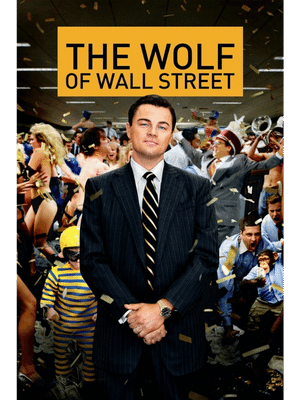
2013, Comedy/Drama, R, 3h
Table of Contents
What Is The Wolf of Wall Street About?
A young, ambitious stockbroker uses unorthodox methods to rise in the world of high finance.
Why You Should Watch The Wolf of Wall Street
Martin Scorsese’s The Wolf of Wall Street is an unflinching portrait of the life and times of Jordan Belfort, a stockbroker whose tumultuous journey of unbridled hedonism and financial fraud is captured with an arresting vigor. Powered by a magnetic performance from Leonardo DiCaprio and an audacious direction by Scorsese, the movie is a captivating exploration of human desire, ambition, and corruption.
The film’s success, to a large extent, can be credited to its potent screenplay, adapted from Belfort’s own memoir by Terence Winter. The narrative is a relentless blitz of wild parties, extravagant wealth, and outrageous behavior, providing an unapologetic peek into the unchecked debauchery of Wall Street in the late 20th century. It maneuvers through the ups and downs of Belfort’s life, effectively highlighting the consequences of his unchecked greed.
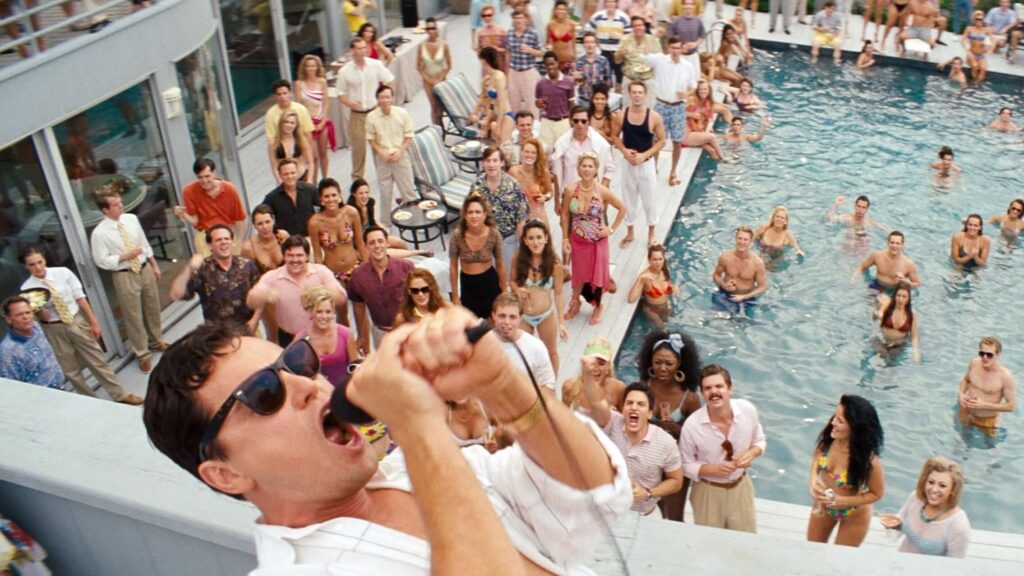
At the heart of The Wolf of Wall Street is a tour-de-force performance by Leonardo DiCaprio. DiCaprio completely immerses himself in the role of Belfort, bringing to life the character’s charm, energy, and narcissism. From his motivational speeches and drug-induced antics to his passionate defense of greed, DiCaprio’s portrayal is nothing short of mesmerizing.
The rest of the cast, including Jonah Hill, Margot Robbie, and Kyle Chandler, deliver excellent performances. Hill, as Belfort’s right-hand man Donnie Azoff, is a standout with his comedic timing and compelling portrayal of excess. Robbie as Naomi, Belfort’s second wife, delivers a strong performance, effectively balancing her character’s glamour and vulnerability. Chandler, as FBI Agent Patrick Denham, provides a worthy adversary to Belfort, embodying the relentless pursuit of justice.
The film’s technical prowess is equally impressive. Cinematographer Rodrigo Prieto paints a vivid picture of Belfort’s world with a dizzying array of camera movements and a glossy color palette that underscores the opulence on display. Thelma Schoonmaker’s sharp editing keeps the narrative engaging, maintaining a breakneck pace that mirrors the protagonist’s high-energy lifestyle.
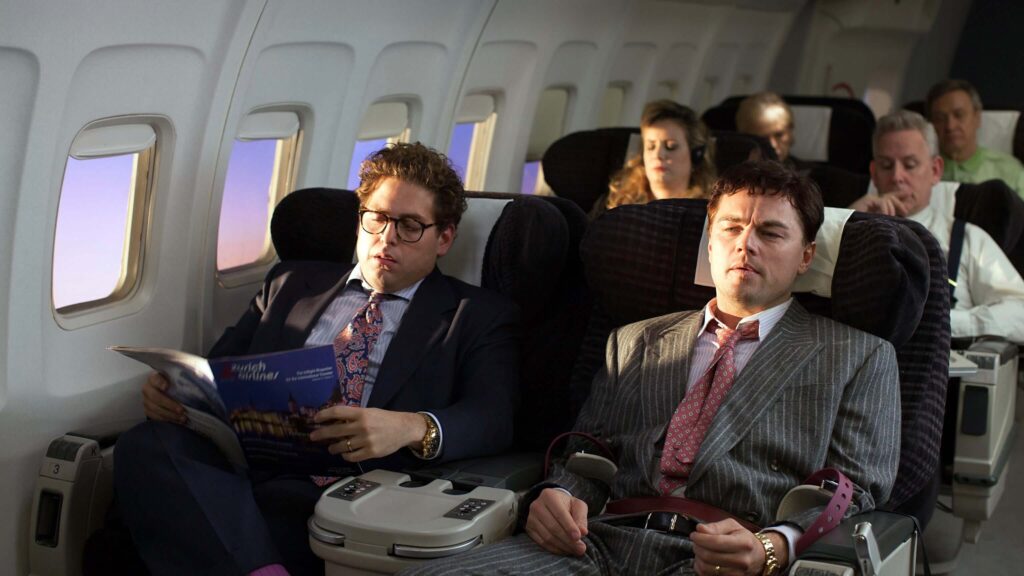
The Wolf of Wall Street remains a remarkable piece of filmmaking. It’s a wild, audacious, and sometimes uncomfortable ride through a world of outrageous excess and moral bankruptcy. At its core, the film is a critique of the culture of greed that can pervade high finance, serving as a cautionary tale about the dangers of unchecked ambition. With its powerhouse performances, deft direction, and sharp screenplay, The Wolf of Wall Street is a testament to Scorsese’s enduring talent and a worthy addition to his impressive filmography.
The Theme of The Wolf of Wall Street
The most prominent theme, perhaps, is the insatiable greed that consumes Belfort and his colleagues. Their relentless pursuit of wealth illustrates the darker side of capitalism, revealing a cutthroat world where ethics and morals are cast aside for the sake of profit. Belfort’s mantra, “greed is good,” encapsulates the ruthlessness of this dog-eat-dog environment. However, the film doesn’t merely condemn this unyielding greed; it seeks to analyze its roots and impacts, demonstrating how it can skew personal values, damage relationships, and ultimately lead to self-destruction.
Closely linked to greed is the theme of hedonism. Belfort’s life is portrayed as a non-stop party filled with drugs, sex, and reckless behavior. The director uses these scenes of excessive indulgence to depict a morally bankrupt culture where immediate gratification trumps all else. The film offers a critique of this hedonistic lifestyle, depicting the physical and emotional toll it takes on Belfort and those around him. Scorsese doesn’t shy away from showing the uglier aspects of this relentless pursuit of pleasure, using it to further emphasize the corrosive effects of unchecked greed.
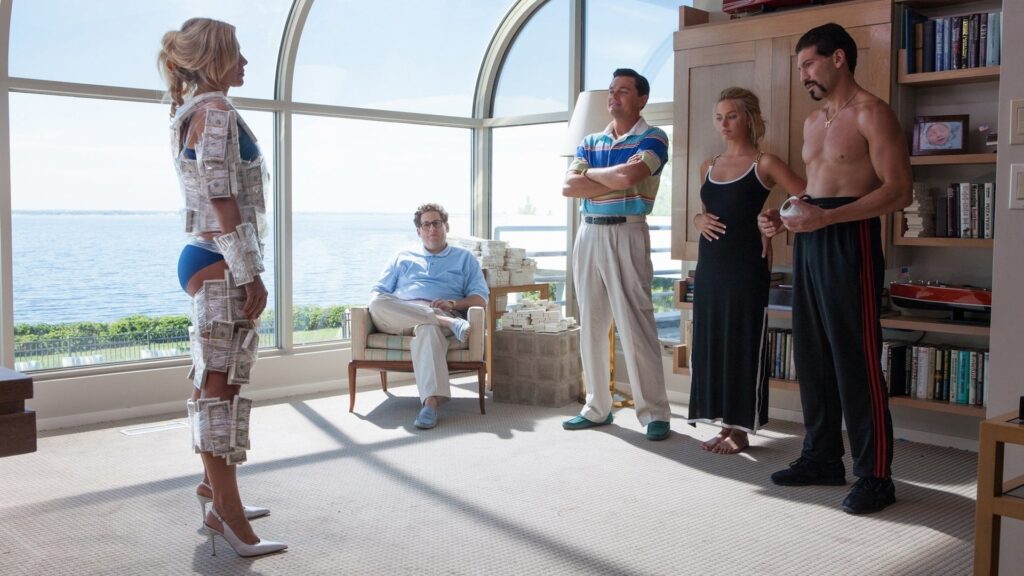
Additionally, the film delves into the concept of the American Dream, presenting a distorted version of this widely cherished ideal. Belfort is initially portrayed as a classic rags-to-riches success story, a self-made man who achieves enormous wealth through hard work and determination. However, as the narrative unfolds, it becomes clear that his version of the American Dream is deeply flawed, built on illegal activities and moral compromises. This representation poses a powerful question about the lengths individuals are willing to go to achieve success and the price they are prepared to pay for it.
The Wolf of Wall Street also explores the theme of manipulation, both at an individual and a systemic level. Belfort is a master manipulator, able to convince others to buy worthless stocks and follow him into illegal activities. This manipulation is also evident in how the financial system operates, as depicted in the film, with powerful players exploiting loopholes and bending the rules to their advantage. This theme further reinforces the film’s critique of unchecked capitalism.
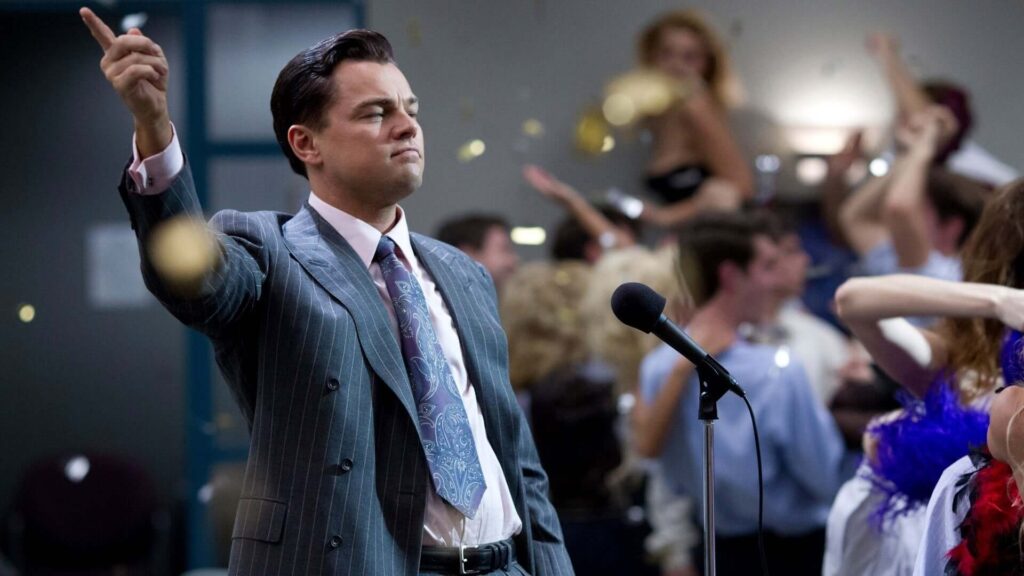
Lastly, the film underscores the theme of consequence and retribution. Belfort’s downfall serves as a stark reminder that actions have consequences. His ultimate punishment, although relatively mild considering his transgressions, is a potent symbol of retribution. However, the film also subtly questions whether the punishment meted out is sufficient, leaving viewers to contemplate the fairness of the system.
The Cinematography of The Wolf of Wall Street
The cinematography of The Wolf of Wall Street, as headed by Rodrigo Prieto, is an integral part of the storytelling. It is characterized by its vibrant and dynamic style, designed to reflect the energetic and excessive lifestyle of its protagonist, Jordan Belfort. A range of camera movements is utilized to mimic the chaotic pace of Belfort’s life. From steady tracking shots and rapid pans to swirling movements, these techniques capture the hectic environment of Stratton Oakmont and the debauchery of Belfort’s parties, thus immersing the audience in the frenzied world of Wall Street.
Prieto employs a warm, rich color palette that mirrors the opulence of Belfort’s world. The colors are bright, glossy, and almost flamboyant, depicting the superficial glamour and the ostentatious wealth at the core of Belfort’s existence. The cinematography is further enhanced by the clever use of point-of-view shots. This subjective camera technique offers the audience a chance to view the world through Belfort’s perspective, particularly during scenes demonstrating his intense drug experiences.
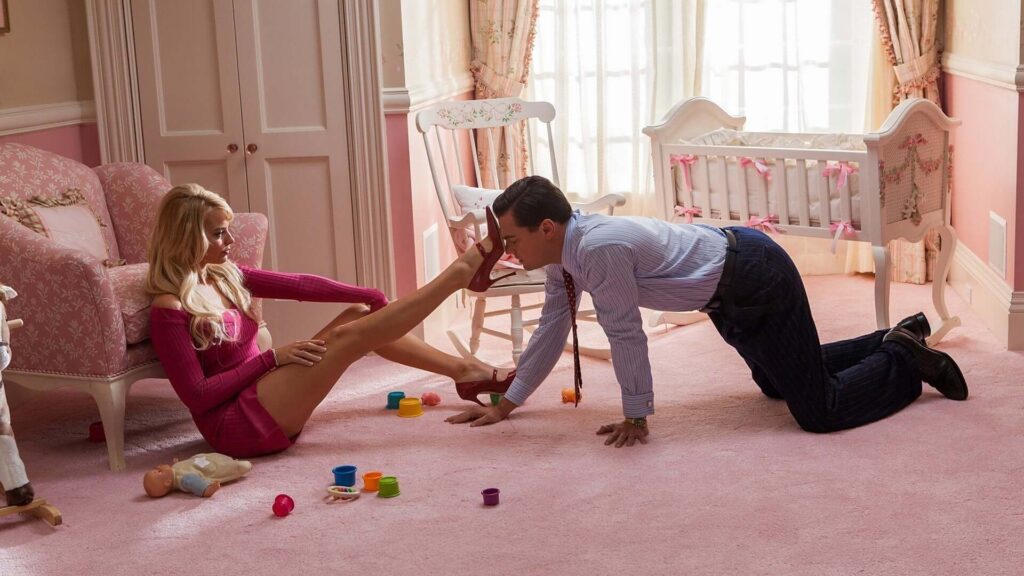
Lighting plays a significant role in setting the tone of the film. The high-contrast lighting creates an atmosphere that ranges from the bright, almost overexposed daylight scenes of the office and parties to the moody and darker hues employed for more intimate or intense scenes. Scorsese and Prieto use long, unbroken takes, also known as ‘oner,’ in several crucial scenes, such as the infamous ‘lemmon’ quaaludes scene, to create comedic or dramatic tension.
Extreme close-ups are strategically used to spotlight the emotional state of characters. Notably, the close-ups on Belfort during his motivational speeches capture his charisma and power, adding a layer of depth to the character’s portrayal. To conclude, the cinematography of The Wolf of Wall Street complements the narrative’s themes of hedonism and excess with its energetic, flamboyant, and expressive visual storytelling.
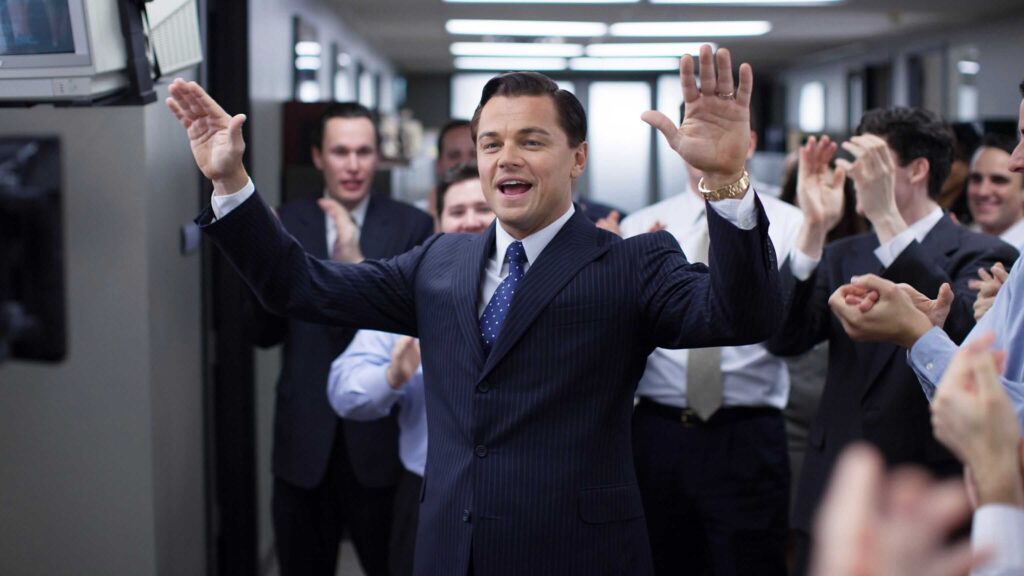
The Soundtrack of The Wolf of Wall Street
The soundtrack of The Wolf of Wall Street doesn’t feature a traditional film score but rather a compilation of music from different periods, selected to reflect the movie’s various moods and scenes. This eclectic mix of music was chosen by longtime Martin Scorsese collaborator Robbie Robertson, who served as the film’s music supervisor.
The film’s soundtrack incorporates a broad range of music styles, including jazz, blues, rock, pop, and even a bit of classical music. This diversity of genres aids in characterizing the film’s chaotic, frenzied ambiance and the unchecked hedonism of its characters.
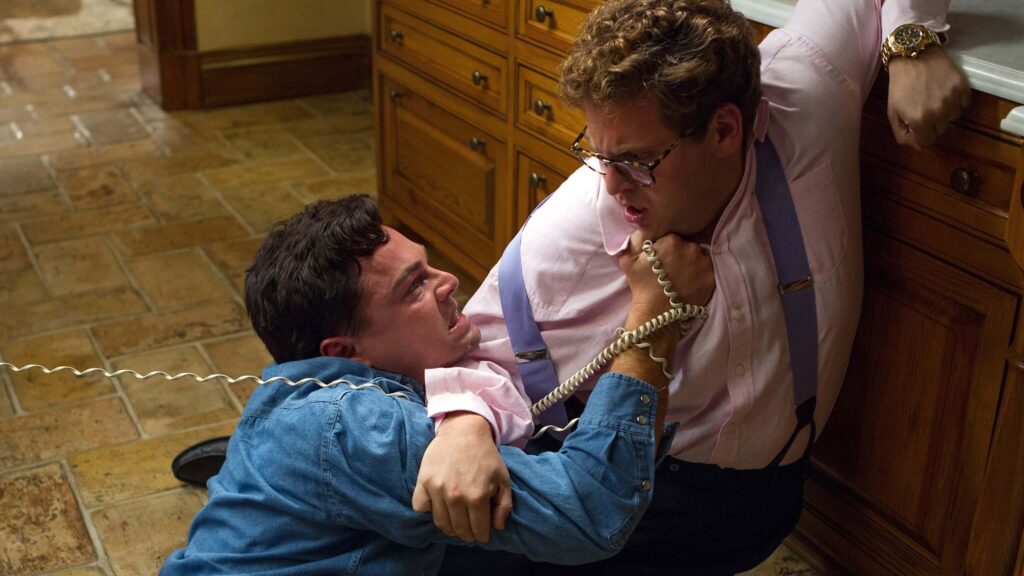
Notable songs include:
- “Mercy, Mercy, Mercy!” by Cannonball Adderley – This song is played during the opening scene of the movie where Jordan Belfort and his colleagues are throwing a dwarf at a target. This sets the tone of reckless debauchery that pervades the movie.
- “In The Bush” by Musique – This disco track is used during the scene when Belfort is introducing his future wife Naomi at one of his extravagant parties.
- “Mrs. Robinson” by The Lemonheads – This cover of the Simon & Garfunkel classic is played when Belfort and his colleagues are going on a road trip to a Swiss bank.
- “Bo Diddley” by Bo Diddley – This song is played during Belfort’s motivational speeches to his employees, providing a rhythmic backdrop to his charismatic persuasions.
- A significant piece that isn’t a song but a composition is “The Money Chant,” performed by Robbie Robertson and Matthew McConaughey. This chant was an improvisation by McConaughey that Scorsese liked so much he decided to incorporate it into the film.
The soundtrack of The Wolf of Wall Street is a character itself. It helps depict the characters’ high-energy lifestyle and reflects the excess, opulence, and chaos of Belfort’s world. You can listen to the original motion picture soundtrack below.
The Cast of The Wolf of Wall Street
- Leonardo DiCaprio as Jordan Belfort – A stockbroker who founded his own firm, Stratton Oakmont.
- Jonah Hill as Donnie Azoff – Donnie is Belfort’s business partner and vice-president at Stratton Oakmont.
- Margot Robbie as Naomi Lapaglia – Belfort’s second wife. Her relationship with Belfort is tumultuous due to his infidelity and drug addiction.
- Matthew McConaughey as Mark Hanna – a senior stockbroker who becomes a mentor to Belfort during his early days in the industry. He introduces Belfort to the culture of excess in the stockbroker world.
- Kyle Chandler as Patrick Denham – An FBI agent tasked with investigating Belfort and his firm’s illicit practices. He plays a key role in Belfort’s eventual downfall.
- Rob Reiner as Max Belfort – Jordan Belfort’s father, who also works at Stratton Oakmont. He serves as the firm’s accountant and the voice of reason, although his advice often goes unheeded.
- Jon Bernthal as Brad Bodnick – A drug dealer who becomes involved with Belfort and his firm. He plays a key role in Belfort’s money-laundering scheme.
- Jean Dujardin as Jean-Jacques Saurel – A Swiss banker who assists Belfort in his money laundering operations.
- Jon Favreau as Manny Riskin – A securities lawyer who provides legal advice to Belfort and his firm.
- Cristin Milioti as Teresa Petrillo – Belfort’s first wife, whom he divorces after meeting Naomi.
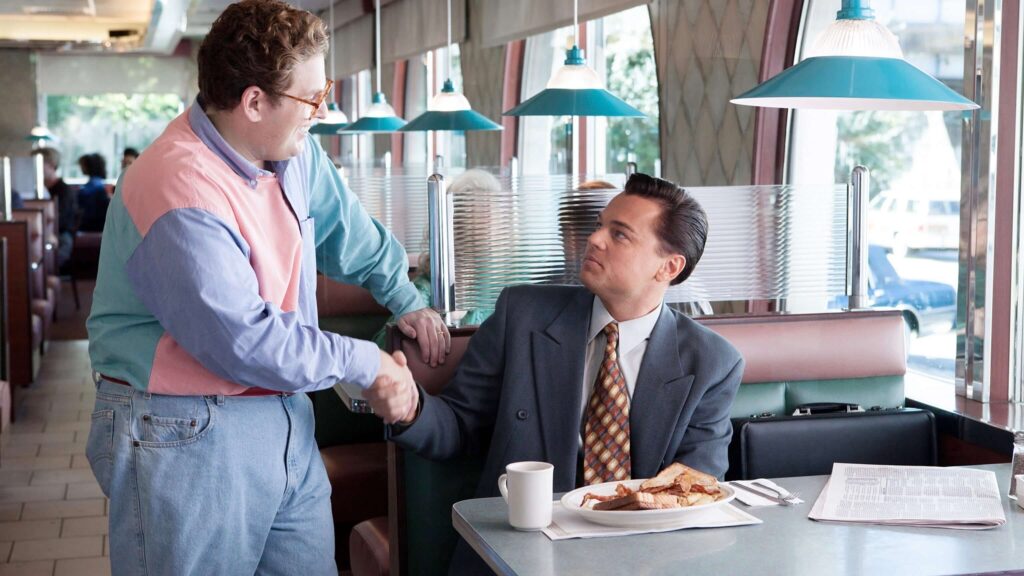
The Filmmakers of The Wolf of Wall Street
- Director: Martin Scorsese
- Producers: Martin Scorsese, Leonardo DiCaprio, Riza Aziz, Joey McFarland, Emma Tillinger Koskoff
- Screenplay: Terence Winter
- Cinematography: Rodrigo Prieto
- Editing: Thelma Schoonmaker
- Music: Robbie Robertson
- Production Companies
- Distributor: Paramount Pictures

Crack Chicken Lasagna

Inspiration
“Smoke crack with me, bro.” – Donnie Azoff
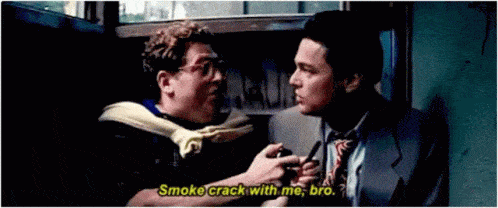
More About The Wolf of Wall Street
The Wolf of Wall Street was filmed in various locations across New York and New Jersey, United States. Although the story is set in different parts of the world, including Switzerland and the Mediterranean, most of these scenes were filmed in the United States.
Here are some specific filming locations:
- Manhattan, New York City: Many scenes were filmed in Manhattan, representing the heart of Wall Street and its surrounding areas.
- Brooklyn, New York City: Some scenes were filmed in Brooklyn, particularly the scene where Belfort gives a speech to his team in a garage. This scene was shot in a warehouse in the Clinton Hill neighborhood.
- Long Island, New York: Several scenes were shot on Long Island, which doubles for Belfort’s upscale home and other locations. The wedding scene between Belfort and Naomi was filmed at the Cullen mansion in Old Westbury, Long Island.
- New Jersey: Some scenes were filmed in Closter, New Jersey, representing Belfort’s first job in a brokerage firm, Investor Center. Other New Jersey locations include Ardsley, Fort Lee, and Middletown.
- Yonkers, New York: The scenes of the Stratton Oakmont offices were filmed in an abandoned warehouse in Yonkers.
- Hamptons, New York: The beach house scenes were filmed in the Hamptons, a wealthy vacation spot on Long Island.
- Harrison, New York: The scene where Belfort’s yacht sinks was filmed in a water tank in Harrison, New York.
- Oyster Bay, New York: Some of the country club scenes were filmed at the Mill Neck Manor in Oyster Bay.
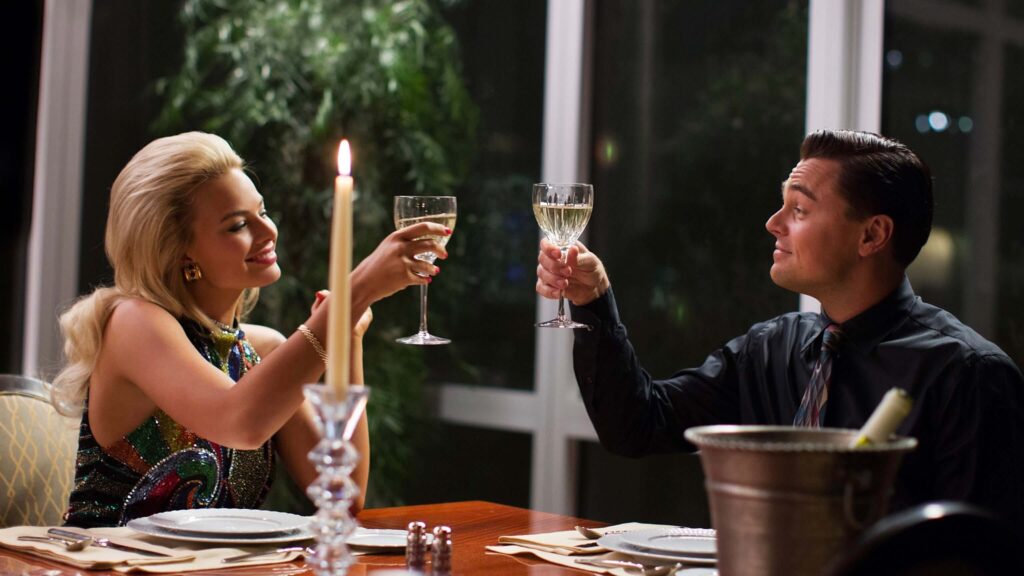
The yacht scene in The Wolf of Wall Street, in which Jordan Belfort’s yacht sinks in a storm, is based on real events. The real Belfort did indeed own a luxury yacht named “Naomi,” which was previously owned by Coco Chanel.
In the late 1990s, Belfort, his wife, and their companions were on a trip to Italy when they hit a rough patch of weather and decided to continue on instead of waiting for the storm to pass. The yacht ultimately sank off the coast of Sardinia, and Belfort and his guests had to be rescued by the Italian Navy.
However, like many aspects of the film, the yacht scene is a dramatized version of real-life events. While the yacht did sink, the circumstances and details of the rescue may have been enhanced for cinematic effect in the movie.

